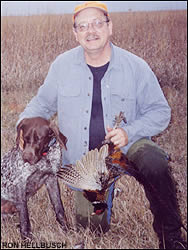| Nelson Recreation |
So much to do . . . So little time? Go ahead. Give yourself permission to take the time.
You'll be glad you did!
ATV Trail
Viet Nam War National Museum
|
|
By
Ron Hellbusch
Special to ESPNOutdoors.com — Jan. 20, 2005 Each fall in Nebraska many folks hope for a good pheasant crop and expect success from their Cornhuskers football team. Thankfully for them the failed gridiron season is over; but the pheasant season is at its peak and hunters are heading to the vast fields that the state has to offer. Meanwhile, Nebraska coach Bill Callahan may want to talk to the state Pheasants Forever chapters to learn the success in their leadership with Nebraska landowners that has led to improved ringneck numbers. Pheasants Forever's survey of prime pheasant-hunting states puts Nebraska at the top of the list. "The biggest gains in pheasant numbers this year appear to be in Nebraska, where July road survey's indicate a 28 percent increase from 2003," the fall report cites. "The northeast portion of the state should provide the most roosters." Nebraska's own fall upland bird survey supports the Pheasants Forever findings and indicates the state's northeast and southeast regions experienced excellent spring nesting conditions and moderate summer rains. “ The biggest gains in pheasant
numbers this year appear to be in Nebraska, where July road survey's
indicate a 28 percent increase from 2003. The northeast portion
of the state should provide the most roosters. ” A recent week in eastern Nebraska resulted in the best hunting experience in years for my party. We learned quickly what counties were most promising, what type of landscape holds the birds and how to get the birds in the air and in the bag. Hunters from Colorado, Wyoming and other surrounding states that lack quality pheasant hunting this season may want to target Nebraska's midsection, east of Grand Island and extending east to the Iowa border. A highway map that outlines counties is a good reference tool in planning a hunt trip. The premier regions are in those eastern counties north of Interstate 80, including Merrick, Nance, Platte, Colfax, Dodge, Butler, York and Saunders. And south of Interstate 80 the most promising counties are Adams, Nuckolls, Fillmore, Saline, Jefferson, Thayer and Johnson. Seeking out Conservation Reserve Program fields should be the first order of business.
Conservation Reserve Program fields typically have dense, tall-standing grass that provides excellent cover for spring nesting and fall and winter pheasant roosting protection. Kent Norquest, an Agent with the Natural Resource Conservation Service in Geneva, Nebr. (Fillmore County), credits the Conservation Reserve Program with the recovery of the pheasant numbers. "Area farmers have been cooperative and quick to step up setting aside thousands of acres of land under the CRP program," Norquest said. "The added acreage is a direct correlation to the increase in the pheasant population. Other terrain that attracts daytime-resting pheasants are creek basins that embrace plum brush, stands of cedar trees and mixes of grass and weed cover. Those creek basins adjacent to harvested corn and milo fields are even likely to be pheasant hangouts. The willingness of farmers to preserve cover by not plowing near fence lines have allowed thick, protective weed and grass stands to flourish and attract pheasants seeking out daytime resting cover.
Call 402-471-0641 or visit www.outdoornebraska.org to start your pheasant-hunting trip planning. A helpful booklet is the "2004 Nebraska Hunt Guide and Public Hunting Lands," which offers state hunting regulations and lists a variety of hunting guides. The 2004-2005 pheasant season extends through Jan. 31, with a daily bag of three and a liberal 12-bird possession limit. Walking corn and milo fields with blockers at the end is the classic method of working through grainfields. Being Olympiclike sprinters, pheasants will not remain in hiding long. Typically birds will run more in grainfields due to the lack of resistance from standing grass and shrubs. A good field dog is the Nebraska pheasant hunter's most valued companion. Dense CRP fields, weeded draws, fence lines and even open corn and milo fields offer pheasants an advantage. Lone hunters oftentimes simply walk past concealed birds. Hunters walking the outside perimeters of a weeded draw with field dogs working the middle of the draws will flush more birds. Similar outside walking patterns down weeded fencerows is the best way to move hiding birds. Large CRP fields take a number of hunters and dogs to work effectively. Birds can easily hide in CRP cover and tend to be patient. The work of a good field dog and a slowe- paced walk in dense cover is a good way to excite concealed birds and get them into the air. Indeed, after some marginal years
in Nebraska, the odds are in the ringneck hunter's favor this season.
|
